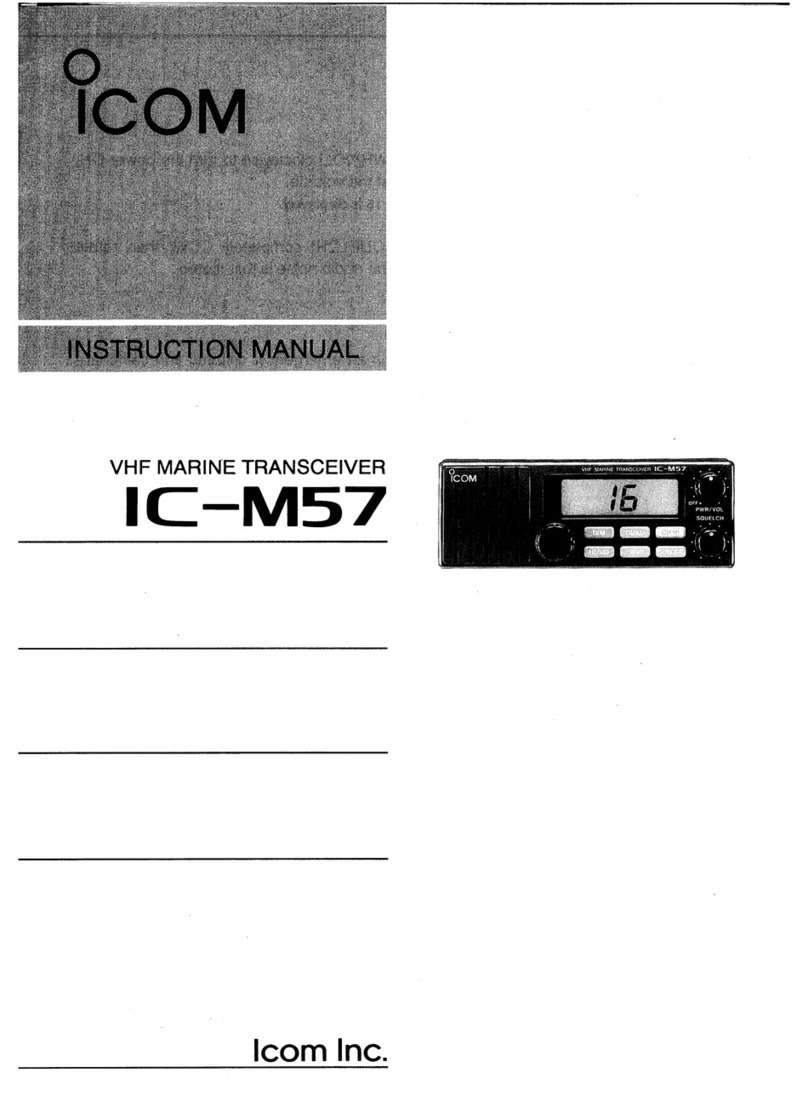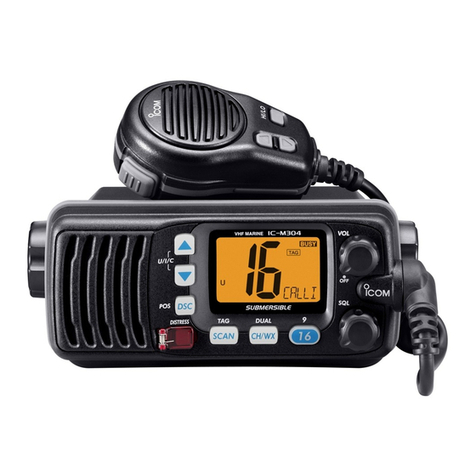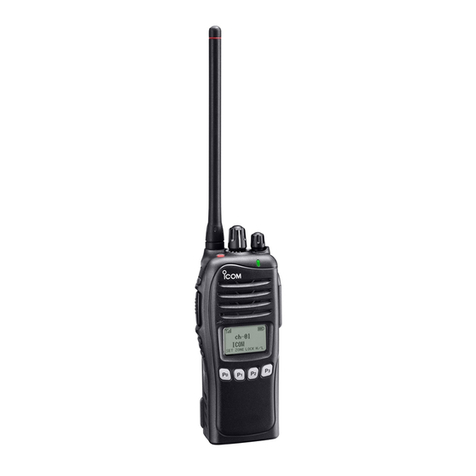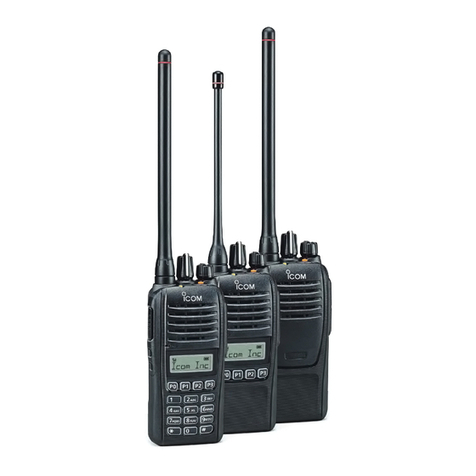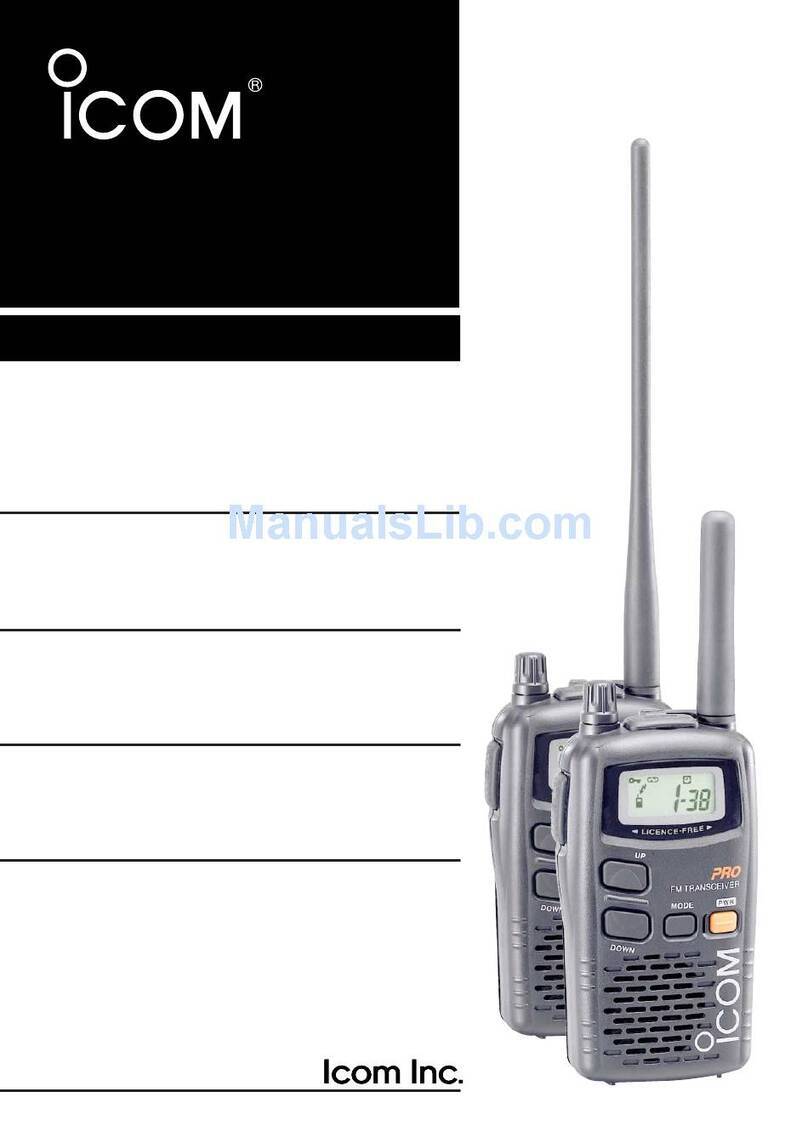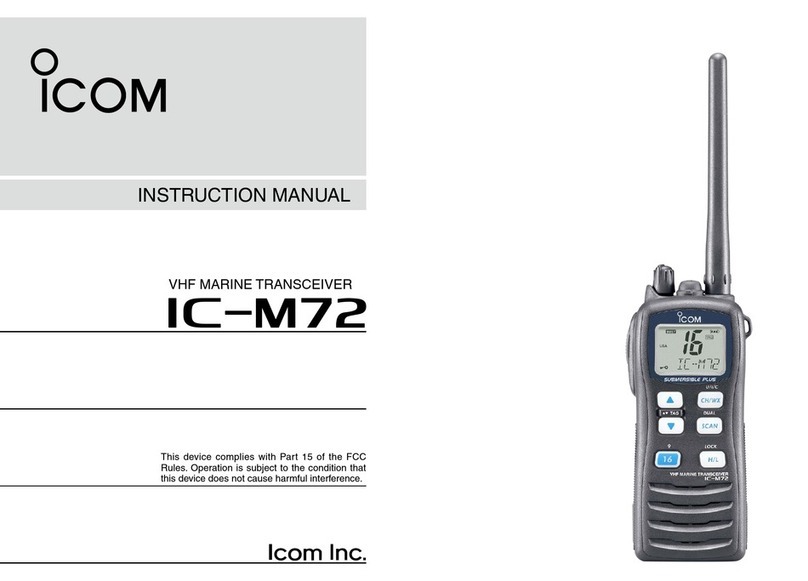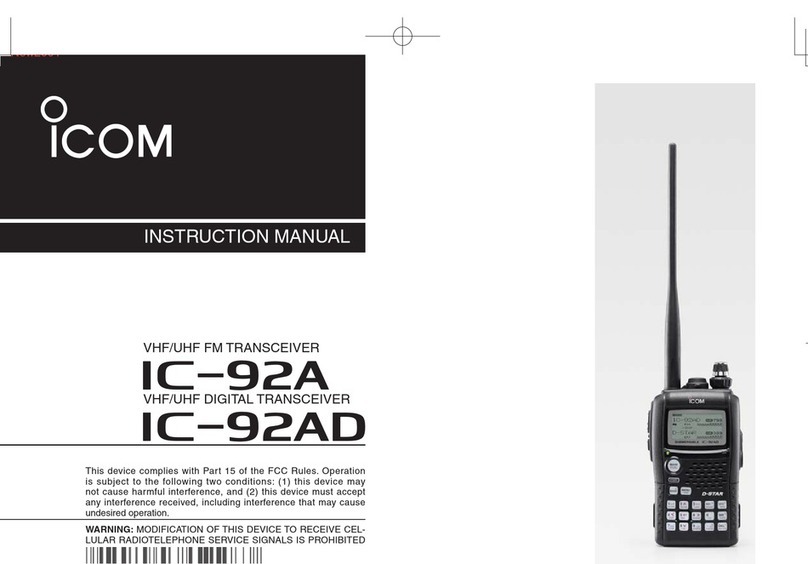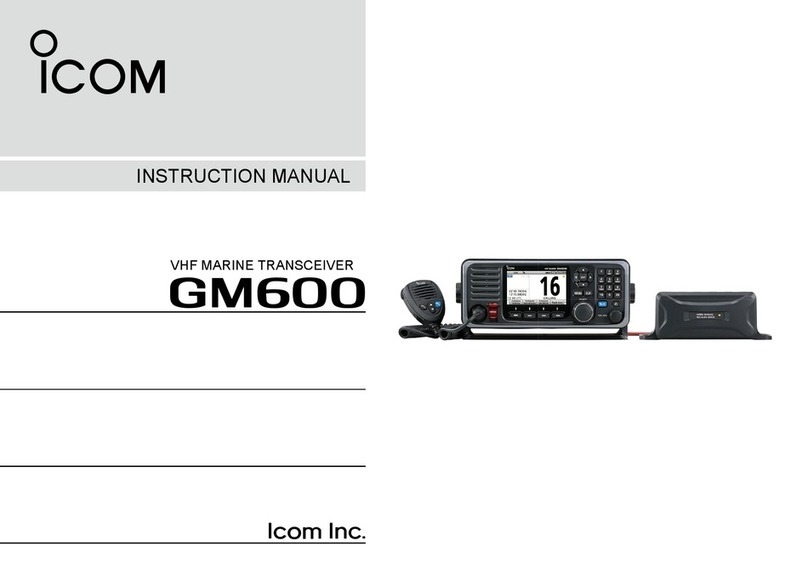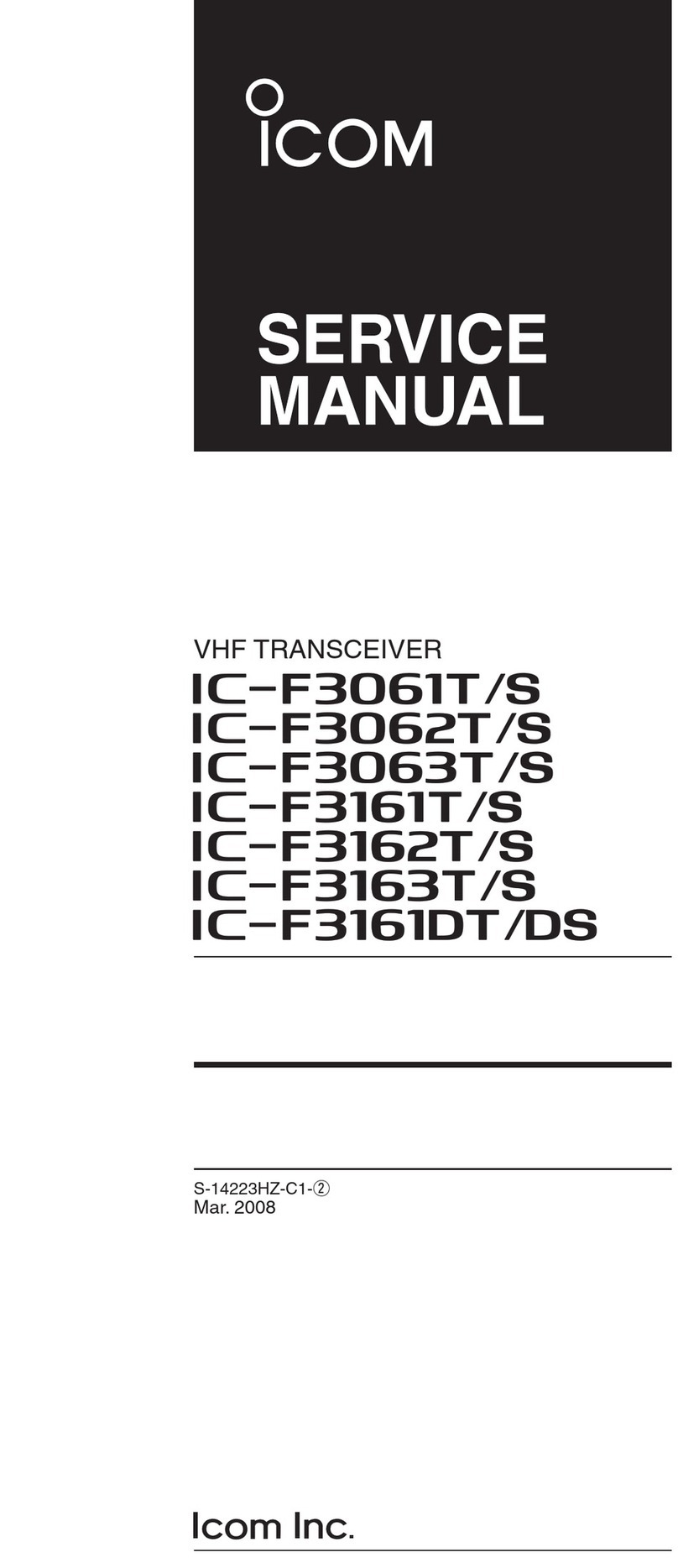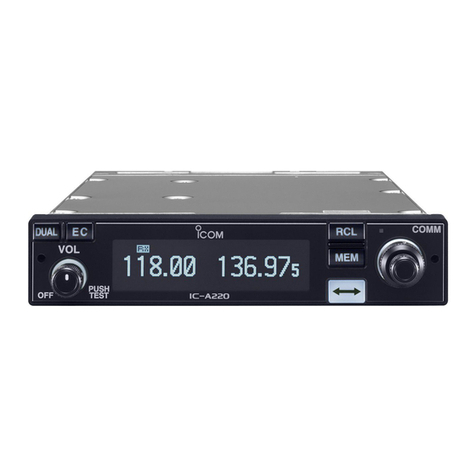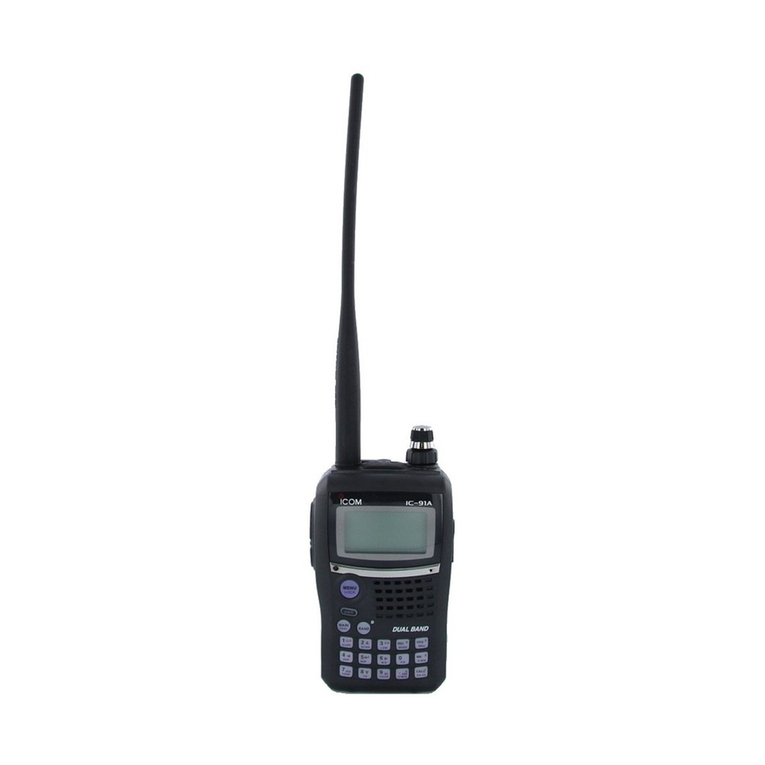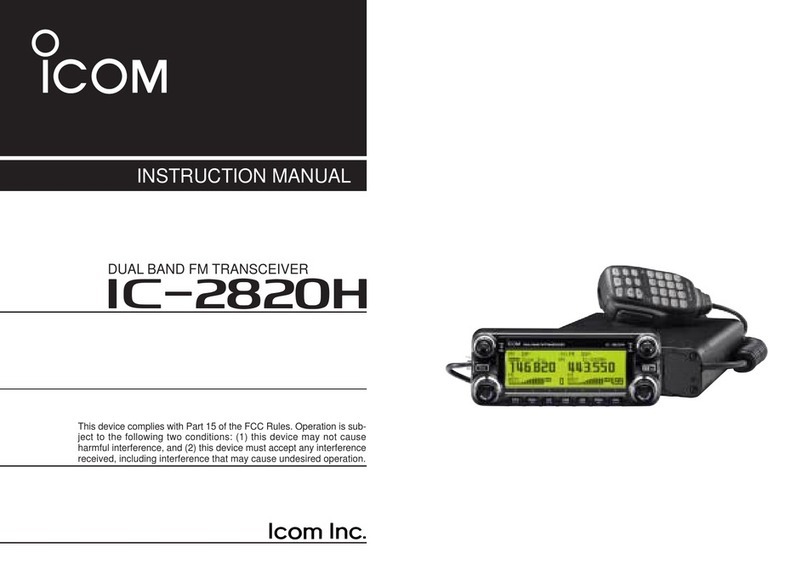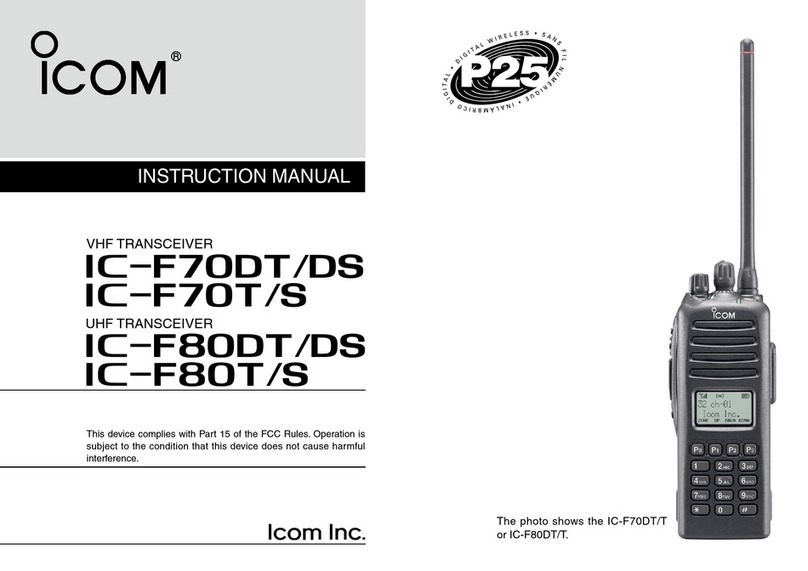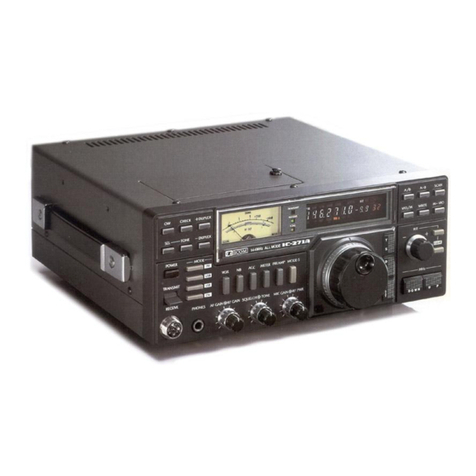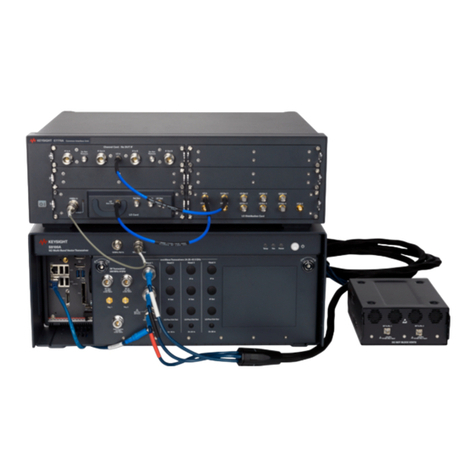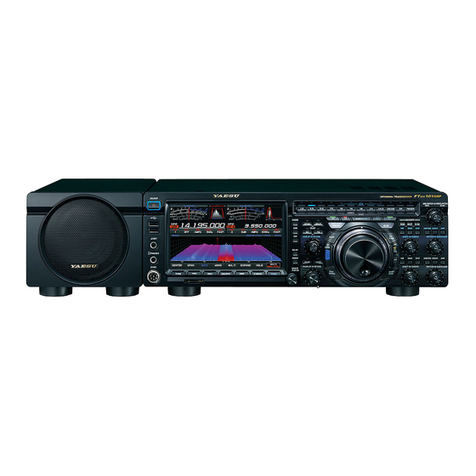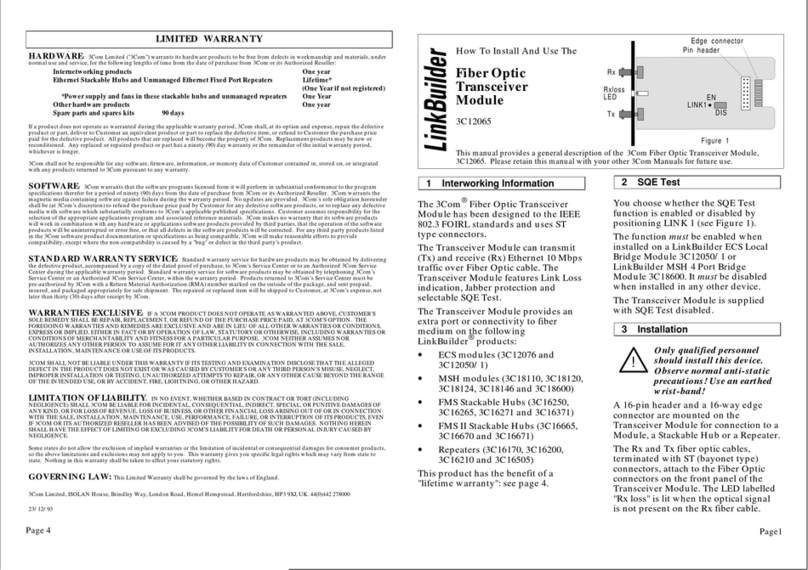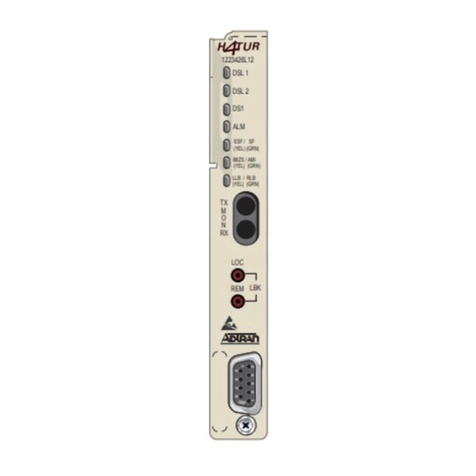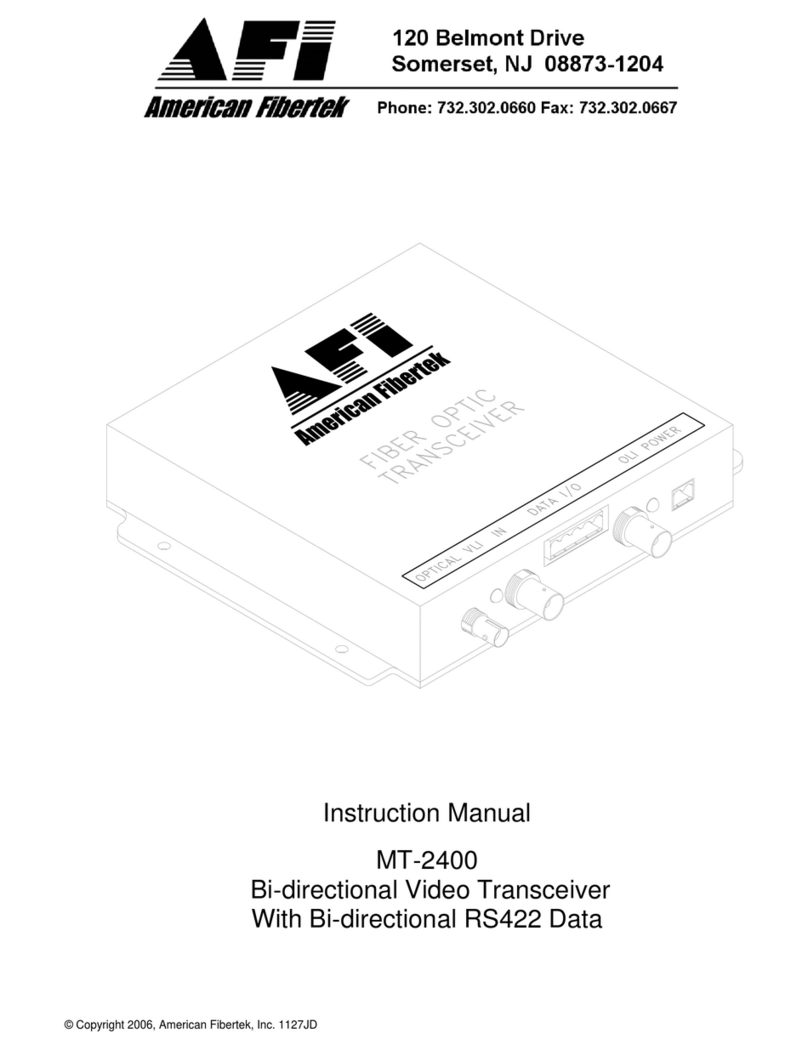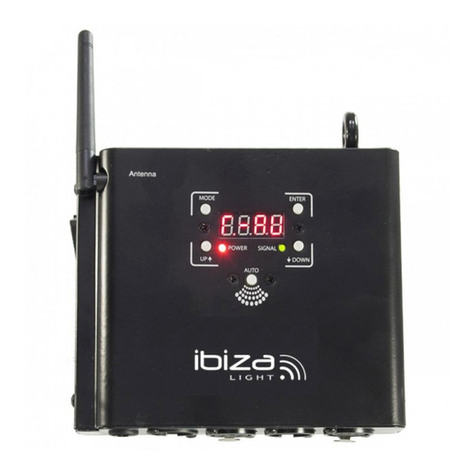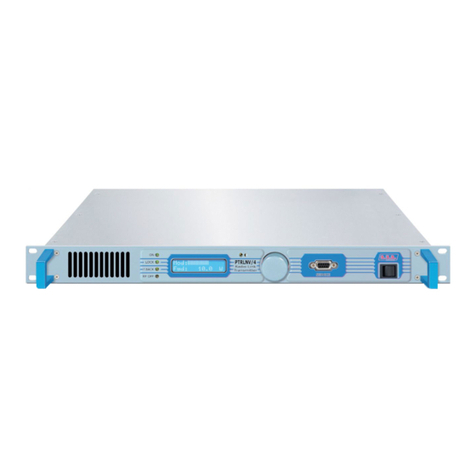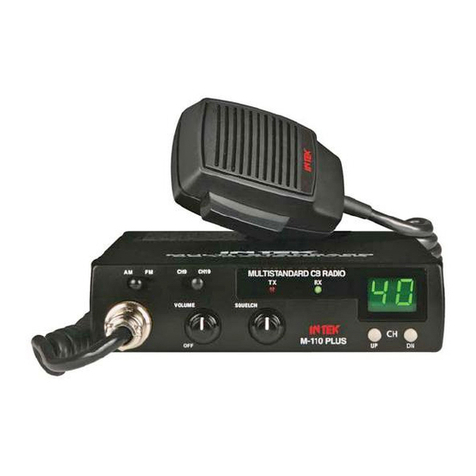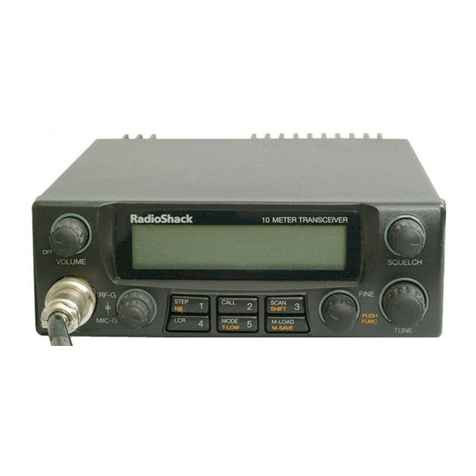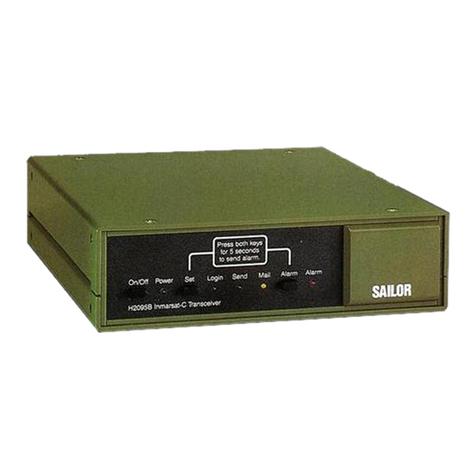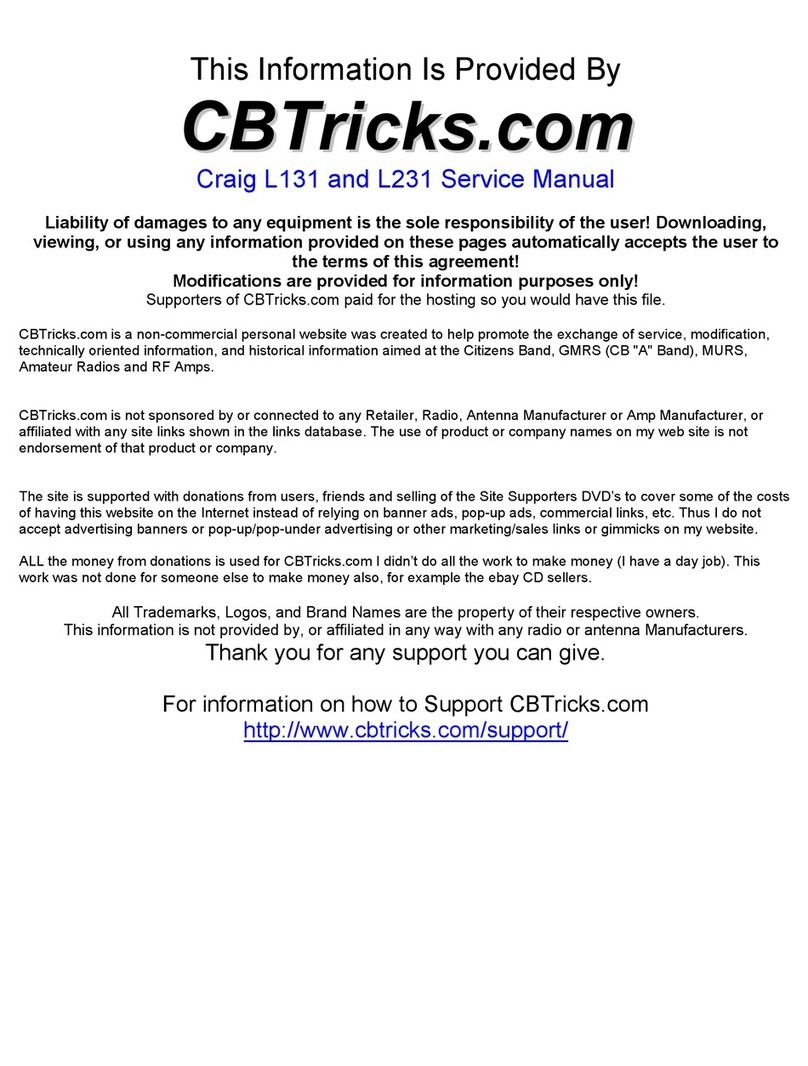Icom IC-F4161T User manual

INSTRUCTION MANUAL
This device complies with Part 15 of the FCC Rules. Operation
is subject to the condition that this device does not cause
harmful interference.
iF4163T/S/DT/DS
iF4161T/S/DT/DS
UHF TRANSCEIVER

i
WORD DEFINITION
RWARNING Personal injury, fire hazard or electric shock
may occur.
CAUTION Equipment damage may occur.
NOTE If disregarded, inconvenience only. No risk
of personal injury, fire or electric shock.
READ ALL INSTRUCTIONS carefully and com-
pletely before using the transceiver.
SAVE THIS INSTRUCTION MANUAL— This
instruction manual contains important operating instructions
for the IC-F3061T/S/F3063T/S VHF TRANSCEIVERS and
IC-F4061T/S/F4063T/S UHF TRANSCEIVERS.
IMPORTANT
Icom, Icom Inc. and the logo are registered trademarks of Icom
Incorporated (Japan) in the United states, the United Kingdom, Germany,
France, Spain, Russia and/or other countries.
EXPLICIT DEFINITIONS

PRECAUTIONS
ii
RCAUTION! NEVERhold the transceiver so that the
antenna is very close to, or touching exposed parts of the
body, especially the face or eyes, while transmitting. The
transceiver will perform best if the microphone is 2 to 4 in. (5
to 10 cm) away from the lips and the transceiver is vertical.
RCAUTION! NEVER operate the transceiver with a
headset or other audio accessories at high volume levels.
RCAUTION! NEVER short the terminals of the bat-
tery pack.
DO NOT push [PTT] when not actually desiring to trans-
mit.
AVOIDusing or placing the transceiver in direct sunlight or
in areas with temperatures below +22°F (–30°C) or above
+140°F (+60°C).
The basic operations, transmission and reception of the trans-
ceiver are guaranteed within the specified operating temper-
ature range. However, the LCD display may not be operate
correctly, or show an indication in the case of long hours of
operation, or after being placed in extremely cold areas.
DO NOT modify the transceiver for any reason.
KEEP the transceiver from the heavy rain, and Never
immerse it in the water. The transceiver construction is water
resistant, not waterproof.
The use of non-Icom battery packs/chargers may impair
transceiver performance and invalidate the warranty.
For U.S.A. only
CAUTION: Changes or modifications to this transceiver, not
expressly approved by Icom Inc., could void your authority to
operate this transceiver under FCC regulations.

iii
IMPORTANT ........................................................................ i
EXPLICIT DEFINITIONS ..................................................... i
PRECAUTIONS .................................................................. ii
TABLE OF CONTENTS ...................................................... iii
1ACCESSORIES ......................................................... 1–3
■Supplied accessories ................................................. 1
■Accessory attachments .............................................. 1
2PANEL DESCRIPTION ............................................. 4–9
■Front panel ................................................................. 4
■Function display ......................................................... 6
■Programmable function keys ..................................... 7
3BASIC OPERATION .............................................. 10–11
■Turning power ON .................................................... 10
■Channel selection .................................................... 10
■Call procedure........................................................... 11
4LTR OPERATION .................................................. 12–13
■Receiving a call ........................................................ 12
■Transmitting a call .................................................... 13
5CONVENTIONAL OPERATION ............................ 14–17
■Receiving and transmitting........................................ 14
■User Set mode.......................................................... 16
■Emergency transmission .......................................... 16
■Scrambler function.................................................... 16
■Stun function ............................................................ 17
■Priority A channel selection ...................................... 17
6BATTERY CHARGING .......................................... 18–22
■Caution ..................................................................... 18
■Optional battery chargers ......................................... 20
7SWIVEL BELT CLIP .............................................. 23–24
■MB-93 contents ........................................................ 23
■To attach .................................................................. 23
■To detach ................................................................. 24
8OPTIONS ..................................................................... 25
9SAFETY TRAINING INFORMATION .................... 28–29
TABLE OF CONTENTS

1
1
ACCESSORIES
■Supplied accessories
The following accessories are supplied: Qty.
qFlexible antenna…………………………………………… 1
wBattery pack ……………………………………………… 1
eBelt clip …………………………………………………… 1
rConnector cover (with screw) ……………………… 1 set
Some accessories are not supplied with depending versions.
■Accessory attachments
DFlexible antenna
Connect the supplied flexible anten-
na to the antenna connector.
CAUTION!
• NEVER HOLD by the antenna
when carrying the transceiver.
• Transmitting without an antenna
may damage the transceiver.
qwe
r

2
1ACCESSORIES
ïBattery pack
To attach the battery pack:
Slide the battery pack in the direction of the arrow (q), then
lock it with the battery release button.
• Slide the battery pack until the battery release button makes a ‘click’
sound.
To release the battery pack:
Slide the battery release button in the direction of the arrow
(w) as shown below. The battery pack is then released.
NEVER release or attach the battery pack when the trans-
ceiver is wet or soiled. This may result water or dust get-
ting into the transceiver/battery pack and may result in the
transceiver being damaged.
DBelt clip
To attach the belt clip:
qRelease the battery pack if it is attached.
wSlide the belt clip in the direction of the arrow until the belt
clip is locked and makes a ‘click’ sound.
To detach the belt clip:
qRelease the battery pack if it is attached.
wPinch the clip (q), and slide the belt clip in the direction of
the arrow (w).
q
w
q
w
Battery release button

3
1
ACCESSORIES
ïConnector cover
Attach the jack cover when the optional speaker-microphone
or head-set is not used.
To attach the connector cover:
qInsert the connector cover into the multi-connector.
wTighten the screw.
CAUTION!
Attach the connector cover when the optional speaker-
microphone is not used.
Otherwise the terminals of the multi-connector may be
shorted by metal object, etc., and this could damege the
transceiver.
To detach the connector cover:
qUnscrew the screw using a phillips screwdriver.
wDetach the connector cover for the speaker-microphone or
head-set connector.
q
w
q
w
Multi-
connector
Connector
cover

4
2PANEL DESCRIPTION
■Front panel
qROTARY SELECTOR
Rotate to select the pre-programmed memory channels or
the operating zone.
(Depending on the pre-setting)
wANTENNA CONNECTOR
Connects the supplied antenna.
eDEALER-PROGRAMMABLE KEY [Emer]
Desired functions can be programmed by your dealer.
((☞ p. 7))
rDEALER-PROGRAMMABLE KEY [Side1]
Desired functions can be programmed by your dealer.
((☞ p. 7))
tPTT SWITCH [PTT]
Push and hold to transmit; release to receive.
yDEALER-PROGRAMMABLE KEYS [Side2]/[Side3]
Desired functions can be programmed independently by
your dealer. ((☞ p. 7))
u10-KEYPAD (Depending on version)
The keypad allows you to enter digits to:
• Select memory channels
• Select tone channels
• Select DTMF codes (during transmit)
• Set TX codes
• Start up with the password
iDEALER-PROGRAMMABLE KEYS [P0] to [P3]
Desired functions can be programmed independently by
your dealer. ((☞ p. 7))
oFUNCTION DISPLAY
Displays a variety of information such as an operating
channel number/name, 2-tone code, DTMF numbers,
selected function, etc.
w
e
t
r
y
q
!1
!0
o
!2
u
i
Microphone
Speaker

5
2
PANEL DESCRIPTION
!0 MULTI-CONNECTOR
Connect an optional speaker-microphone.
!1 BUSY/TRANSMIT INDICATOR
➥ Lights green while receiving a signal, or when the
squelch is open.
➥ Lights red while transmitting.
!2 VOLUME CONTROL [VOL]
Rotate to turn the power ON/OFF and adjusts the audio
level.
Connector cover
NOTE: Attach the connector
cover when the optional speak-
er-microphone is not used.
See ((☞ p. 3)) for details.

6
2PANEL DESCRIPTION
■Function display
qSIGNAL STRENGTH INDICATOR
Indicates relative signal strength level.
wLOW POWER INDICATOR
Appears when low output power is selected.
eAUDIBLE INDICATOR
➥Appears when the channel is in the ‘audible’ (unmute)
condition.
➥Appears when the specified 2-tone is received.
rCOMPANDER INDICATOR
Appears when the compander function is activated.
tSCRAMBLER INDICATOR
Appears when the voice scrambler function is activated.
yBELL INDICATOR
➥Appears/blinks when the specific 2-tone/DTMF select
call is received, according to the pre-programming.
uCALL CODE MEMORY INDICATOR
Appears when the call code memory is selected.
iBATTERY INDICATOR
Appears or blinks when the battery power decreases to a
specified level.
oALPHANUMERIC DISPLAY
➥Displays an operating channel number, channel name,
Set mode contents, DTMF code, etc.
➥The indication mode can be selected from 1 line or 2
lines. Ask your dealer for details.
• In this instruction manual, the LCD illustration is described
using the 2 lines indication mode.
!0 KEY INDICATOR
Indicate the programmed function of the front panel keys
([P0], [P1], [P2] and [P3]).
q t iuyrew
o
!0

7
2
PANEL DESCRIPTION
■Programmable function keys
The following functions can be assigned to [Emer],[Side1],
[Side2], [Side3], [P0], [P1], [P2] and [P3] programmable
function keys.
Consult your Icom dealer or system operator for details con-
cerning your transceivers programming.
If the programmable function names are bracketed in the fol-
lowing explanations, the specific key is used to activate the
function depends on the programming.
CH UP AND DOWN KEYS “UUPP” “DDOOWWNN”
➥Push to select an operating channel.
➥Push to select a transmit code channel after pushing [TX
Code CH Select].
➥Push to select a DTMF channel after pushing [DTMF
Autodial].
➥Push to select a scan group after pushing and holding
[Scan A Start/Stop]/[Scan B Start/Stop].
ZONE KEY “ZZOONNEE”
Push this key, then push [CH Up] or [CH Down] to select the
desired zone.
What is “zone”?— The desired channels are assigned
into a zone according to the intended use for grouping. For
example, ‘Staff A’ and ‘Staff B’ are assigned into a
“Business” zone, and ‘John’ and ‘Cindy’ are assigned into a
“Private” zone.
SCAN A KEY “SSCCNNAA”
➥This key’s operation depends on the Power ON Scan set-
ting.
When the power ON scan function is turned OFF;
Push to start and cancel scanning operation. In case of
transmission during scan, cancels scanning.
When the power ON scan function is turned ON;
Push to pause scanning., then resumes scanning after
passing a specified time period. In case of transmission
during scan, scanning will be canceled.
➥Push and hold this key for 1 sec. to indicate the scan
group, then push [CH Up] or [CH Down] to select the
desired group.
SCAN B KEY “SSCCNNBB”
➥Push to start and cancel scanning operation. In case of
transmission during scan, pauses scanning. Scanning
resumes after passing a specified time period.
➥Push and hold this key for 1 sec. to indicate the scan
group, then push [CH Up] or [CH Down] to select the
desired group.

8
2PANEL DESCRIPTION
SCAN ADD/DEL (TAG) KEY “SSCCAADD”
Push to add or delete the selected channel to/from the scan
group.
PRIO A/B KEYS “PPRRAA” “PPRRAARR” “PPRRBB” “PPRRBBRR”
➥Push to select Priority A or Priority B channel.
➥Push and hold [Prio A (Rewrite)] to rewrite the Prio A chan-
nel.
MR-CH 1/2/3/4 KEYS “CCHH11” “CCHH22” “CCHH33” “CCHH44”
Push to select an operating channel directly.
MONI KEY “MMOONN”
Mute and release the CTCSS (DTCS) or 2-tone squelch
mute. Open any squelch/deactivate any mute while pushing
this key.
LIGHT KEY “LLIIGGTT”
Push to turn the transceiver’s backlight ON temporarily only
when the backlight function is turned OFF in user set mode.
LOCK KEY “LLOOCCKK”
➥Push and hold for 1 sec. to electronically lock all program-
mable keys except the following:
[Call] (incl. Call A and Call B), [Moni(Audi)] and
[Emergency].
➥Push and hold for 1 sec. again to turn the lock function
OFF.
HIGH/LOW KEY “HH//LL”
Push to select the transmit output power temporarily or per-
manently, depending on the pre-setting.
•Ask your dealer for the output power level for each selection.
C.TONE CH ENT KEY “TTSSEELL”
Push to select the continuous tone channel using
[CH Up]/[CH Down] to change the tone frequency/code set-
ting. The selected channel remains set as the continuous
tone channel until another channel is designated as such.
TALK AROUND KEY “TTAA”
Push to turn the talk around function ON and OFF.
•The talk around function equalizes the transmit frequency to the
receive frequency for transceiver-to-transceiver communication.
WIDE/NARROW KEY “WW//NN”
Push to toggle the IF bandwidth between wide and narrow.
DTMF AUTODIAL KEY “DDTTMMAA”
➥Push to enter the DTMF channel selection mode. Then
select the desired DTMF channel using [CH Up]/[CH
Down].
➥After selecting the desired DTMF channel, push this key to
transmit the DTMF code.
RE-DIAL KEY “DDTTMMRR”
Push to transmit the last-transmitted DTMF code.

9
2
PANEL DESCRIPTION
CALL KEYS “CCAALLLL” “CCAALLAA” “CCAALLBB”
Push to transmit a 2-tone.
•Call transmission is necessary before you call another station
depending on your signaling system.
•[CallA] and/or [Call B] may be available when your system employs
selective ‘Individual/Group’ calls. Ask your dealer which call is
assigned to each key.
EMERGENCY KEY “EEMMRR”
Push and hold for a specified period to transmit an emer-
gency call.
• If you want to cancel the emergency call, push (or push and hold)
the key again before transmitting the call.
• The emergency call is transmitted one time only or repeatedly until
receiving a control code depending on the pre-setting.
SURVEILLANCE KEY “SSUURRVV”
Push to turn the surveillance function ON or OFF.
When this function is turned ON, the beep is not emitted and
the LCD backlight does not light when a signal is received or
a key is pushed, etc.
TX CODE CHANNEL SELECT KEY “TTXXCC”
➥Push to enter the ID code channel selection mode directly.
Then set the desired channel using [CH Up]/[CH Down].
((☞p. 15))
TX CODE CHANNEL UP/DOWN KEYS “TTXXCCUU” “TTXXCCDD”
Push to select a TX code channel directly.
SCRAMBLER FUNCTION “SSCCRR”
Push to toggle the voice scrambler function ON and OFF.
COMPANDER KEY “CCOOMMPP”
Push to toggle the compander function ON and OFF.
The compander function reduces noise components from the
transmitting audio to provide clear communication.
PHONE KEY “PPHHNN”
Push to connect or disconnect the telephone network con-
nection during LTR operation.
USER SET MODE KEY “SSEETT”
➥Push and hold to enter user set mode.
• During user set mode, push this key to select an item, and
change the value or condition using push [CH Up]/[CH Down].
➥Push and hold this key again to exit user set mode.
User set mode is also available via the ‘Power ON function.’
Refer to ((☞p. 16)) also.
OPT OUT KEYS “OOPP11” “OOPP22” “OOPP33”
Push to control the output signal level of the optional ports in
the optional unit connector.
OPT MOMENTARY KEYS “OO11MM” “OO22MM” “OO33MM”
Push and hold to control the output signal level of the option-
al ports in the optional unit connector.

■Turning power ON
Prior to using the transceiver for the first time, the battery
pack must be fully charged for optimum life and operation.
((☞p. 20))
qRotate [VOL] to turn the power ON.
wIf the transceiver is programmed for a start up password,
input the digit codes as directed by your dealer.
• 10-keypad can be used for password input depending on ver-
sion:
• The keys in the table below can be used for password input:
• The transceiver detects numbers in the same block as identical.
Therefore “01234” and “56789” are the same.
eWhen the “PASSWORD” indication does not clear after
inputting 4 digits, the input code number may be incorrect.
Turn the power off and start over in this case.
■Channel selection
Several types of channel selections are available. Methods
may differ according to your system set up.
NON-ZONE TYPE:
Push [CH Up] or [CH Down], or rotate [ROTARY SELEC-
TOR]* to select the desired operating channel, in sequence;
or, push one of [MR-CH 1] to [MR-CH 4] keys to select a
channel directly.
• Up to 16 pre-programmed channels can be selected via [ROTARY
SELECTOR].*
ZONE TYPE:
Push [Zone], then push [CH Up] or [CH Down] or rotate
[ROTARY SELECTOR]* to select the desired zone.
AUTOMATIC SCAN TYPE:
Channel setting is not necessary for this type. When turning
power ON, the transceiver automatically starts scanning.
Scanning stops when receiving a call.
*Depending on the pre-setting.
KEY
NUMBER 0
54
9
3
8
2
7
1
6
(Side3)
10
3BASIC OPERATION

11
3
BASIC OPERATION
■Call procedure
When your system employs tone signaling (excluding CTCSS
and DTCS), the call procedure may be necessary prior to voice
transmission. The tone signaling employed may be a selective
calling system which allows you to call specific station(s) only
and prevent unwanted stations from contacting you.
qSelect the desired TX code channel or 2-tone code
according to your System Operator’s instructions.
• This may not be necessary depending on programming.
• Refer to ((☞ pages. 14 or 15)) for selection.
wPush the call key (assigned to one of the dealer program-
mable keys: [Emer], [Side1], [Side2], [Side3], [P0], [P1],
[P2] and [P3]) or [PTT].
eAfter transmitting a 2-tone code, the remainder of your
communication can be carried out in the normal fashion.
Selective calling Non-selective calling

■Receiving a call
DGroup call
qPush [CH Up] or [CH Down], or rotate [ROTARY SELEC-
TOR]* to select the LTR system channel or talk group.
wWhen a call is received;
•‘BUSY’ indicator lights green.
ePush and hold [PTT], then speak into the microphone at a
normal voice level.
rRelease [PTT] to return to receive.
DSelective call (DTMF call)
qPush [CH Up] or [CH Down], or rotate [ROTARY SELEC-
TOR]* to select the LTR system channel or talk group.
wPush [Call] to mute the channel.
eWhen receiving a call, the calling station name appears
and a beep is emitted. Then the mute is released.
•“”appears.
*:Depending on the pre-setting.
DPhone call
• Receive a phone call
qPush [CH Up] or [CH Down], or rotate [ROTARY SELEC-
TOR]* to select the phone channel of LTR system chan-
nel.
•“”appears.
wWhen a phone call is received (transceiver rings), push
[PHONE] (or push [PTT]).
•“”blinks.
ePush and hold [PTT], then speak into the microphone at a
normal voice level. Release [PTT] to return to receive.
rAfter conversation is finished, push [PHONE] (or while
pushing and holding [PTT], push [#]) to disconnect the
phone call.
•“”stops blinking.
002 ch-03
fH 173.7M
Blinks
002 ch-03
fH 173.7M
Appears
12
4LTR OPERATION

13
4
LTR OPERATION
• Make a phone call
qSelect the phone channel of LTR system channel.
•“”appears.
wPush [PHONE] (or push [PTT]).
•“”blinks.
ePush [DTMFAutodial] (or while pushing and holding [PTT]
enter the desired telephone number using 10 key pad) to
make a phone call.
rAfter conversation is finished, push [PHONE] (or while
pushing and holding [PTT], push [#]) to disconnect the
phone call.
•“”stops blinking.
*:Depending on the pre-setting.
■Transmitting a call
DGroup call
qPush [CH Up] or [CH Down], or rotate [ROTARY SELEC-
TOR]* to select the LTR system channel or talk group.
wWhile pushing and holding [PTT], speak into the micro-
phone at a normal voice level after a beep is emitted.
• If an error beep is emitted, release [PTT]. After a while, repeat
step w.
• The beep can be turned OFF in User set mode.
DSelective call (DTMF call)
qPush [CH Up] or [CH Down], or rotate [ROTARY SELEC-
TOR*] to select the LTR system channel or talk group.
wPush [DTMF Autodial]— a DTMF encode channel
appears.
ePush [CH Up] or [CH Down] to select the desired DTMF
encode channel.
rPush [PTT] to transmit the selected DTMF code in the
selected DTMF channel.
• Push [DTMF Autodial] to cancel the DTMF transmission.
002 ch-03
fH 173.7M
Blinks

14
5CONVENTIONAL OPERATION
■Receiving and transmitting
NOTE: Transmitting without an antenna may damage the
transceiver. See ((☞p. 1)) for accessory attachments.
Receiving:
qRotate [VOL] to turn the power ON.
wPush [CH Up] or [CH Down], or rotate [ROTARY SELEC-
TOR]* to select the conventional system channel, in
sequence.
*Depending on the pre-setting.
eWhen receiving a call, adjust the audio output level to a
comfortable listening level.
Transmitting:
Wait for the channel to become clear to avoid interference.
qPush [Call] when initiating a call from your side.
• Coded audio may be heard from the transceiver, then “”
appears.
• This operation may not be necessary depending on your signal-
ing system. Ask your dealer for details.
wWhile pushing and holding [PTT], speak into the micro-
phone at a normal voice level.
eRelease [PTT] to return to receive.
IMPORTANT: To maximize the readability of your signal;
1. Pause briefly after pushing [PTT].
2. Hold the microphone 5 to 10 cm (2 to 4 inches) from
your mouth, then speak into the microphone at a nor-
mal voice level.
DTransmitting notes
• Transmit inhibit function
The transceiver has several inhibit functions which restrict
transmission under the following conditions:
- The channel is in mute condition (‘Inaudible’ condition;
“”does not appear.)
- The channel is busy.
- Un-matched (or matched) CTCSS is received.
(Depending on the pre-setting.)
- The selected channel is a ‘receive only’ channel.
• Time-out timer
After continuous transmission for the pre-programmed time
period, the time-out timer is activated, causing the transceiv-
er to stop transmitting.
• Penalty timer
Once the time-out timer is activated, transmission is further
inhibited for a period determined by the penalty timer.

15
5
CONVENTIONAL OPERATION
DTX code channel selection
If the transceiver has [TX Code CH Select] assigned to it, the
indication can be toggled between the operating channel
number (or name) and TX code channel number (or name).
When the TX code channel number (or name) is displayed,
[CH Up] or [CH Down] selects the TX code channel.
USING [TX CODE CH SELECT] KEY:
qPush [TX Code CH Select]— a TX code channel number
(or name) appears.
wPush [CH Up] or [CH Down] to select the desired TX code
channel.
ePush [Call] (or [PTT] during MSK operation) to transmit the
selected TX code.
rPush [TX Code CH Select] again to return to the operat-
ing channel number indication.
USING [TX CODE CH UP]/[TX CODE CH DOWN] KEY:
If the transceiver has a [TX Code CH Up] or [TX Code CH
Down] key assignment, the programmed TX code channel
can be selected directly when pushed.
DDTMF transmission
If the transceiver has [DTMFAutodial] assigned to it, the auto-
matic DTMF transmission function is available. Up to 8 DTMF
channels are available.
TO SELECT A TX CODE:
qPush [DTMF Autodial]— a DTMF channel appears.
wPush [CH Up] or [CH Down] to select the desired DTMF
channel.
ePush [DTMF Autodial] to transmit the DTMF code in the
selected DTMF channel.

16
5CONVENTIONAL OPERATION
■User set mode
User set mode is accessed at power ON and allows you to
set seldom-changed settings. In this case you can “cus-
tomize” the transceiver operation to suit your preferences and
operating style.
Entering the user set mode:
qWhile pushing and holding [P1] and [P2], rotate [VOL] to
turn the power ON. Then, push and hold [P0] to enter user
set mode.
wPush [P0] several times to select the appropriate item.
Then push [Side2] or [Side3] to set the desired level/con-
dition.
•Available set mode functions are Backlight, LCD contrast,
Beep, Beep Level, Ringer Level, SQL Level, AF Min Level,
Mic Gain, VOX Gain, VOX Delay, Battery Voltage and Signal
Moni.
eRotate [VOL] to turn the power OFF to exit user set mode.
NOTE: User set mode is also available via a programma-
ble key. Please refer to ((☞p. 9)) [User Set Mode] section.
■Emergency transmission
When [Emergency Single] or [Emergency Repeat] is pushed,
an emergency signal is automatically transmitted for the spec-
ified time period.
When [Emergency] is pushed, the DTMF emergency signal
is transmitted on the priority channel.
When [Emergency Single] or [Emergency Repeat] is pushed
for the specified time period, the DTMF emergency signal is
transmitted once or repeatedly on the emergency channel.
However, when no emergency channel is specified, the signal
is transmitted on the previously selected channel.
■Scrambler function
The voice scrambler function provides private communication
between stations. The frequency inversion type is equipped
to all versions, moreover, the optional Rolling or Non-rolling
type can be available.
qPush [Scrambler] to turn the scrambler function ON.
• “ ” appears.
wPush [Scrambler] again to turn the scrambler function
OFF.
• “ ” disappears.
This manual suits for next models
7
Table of contents
Other Icom Transceiver manuals

